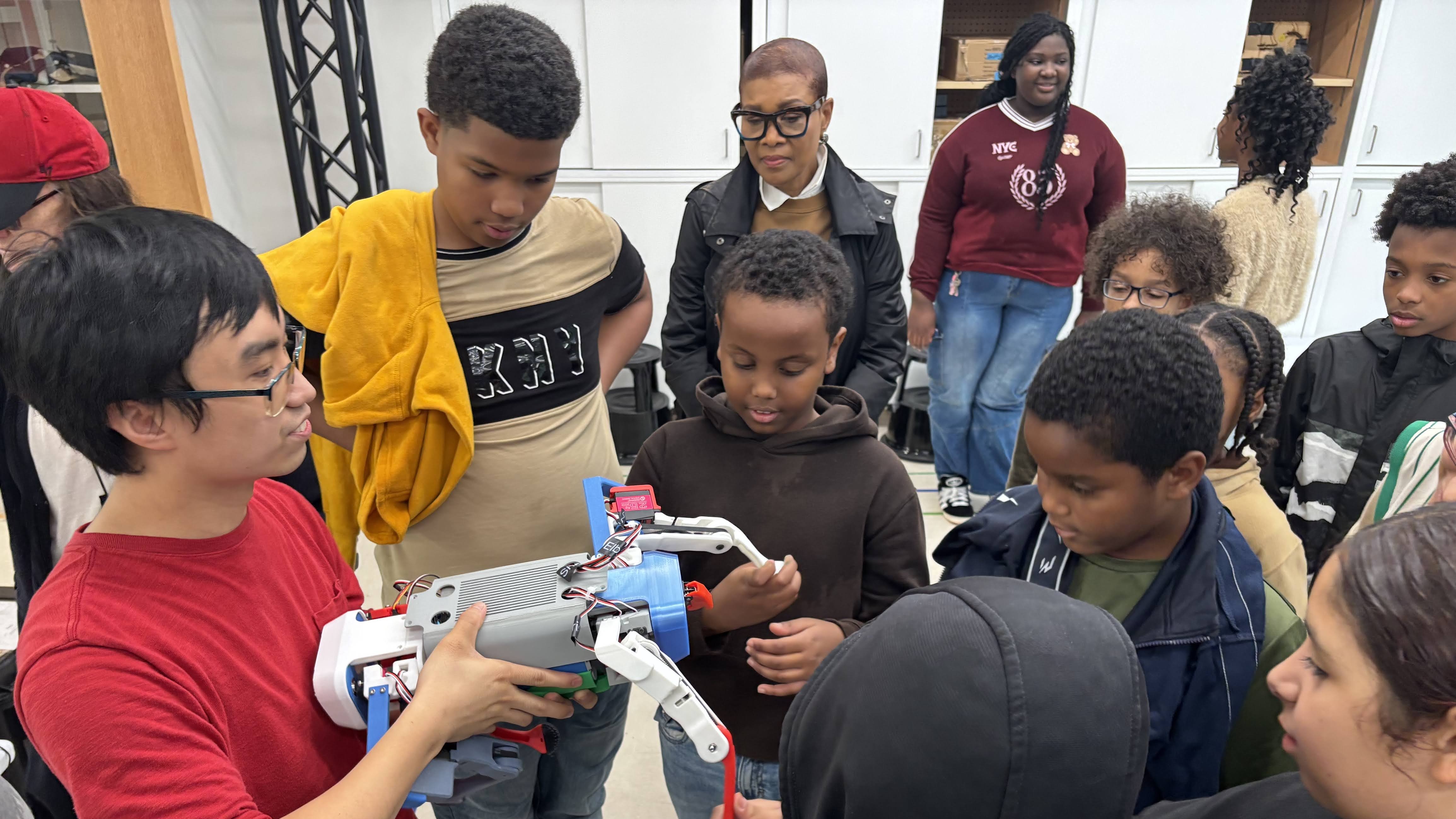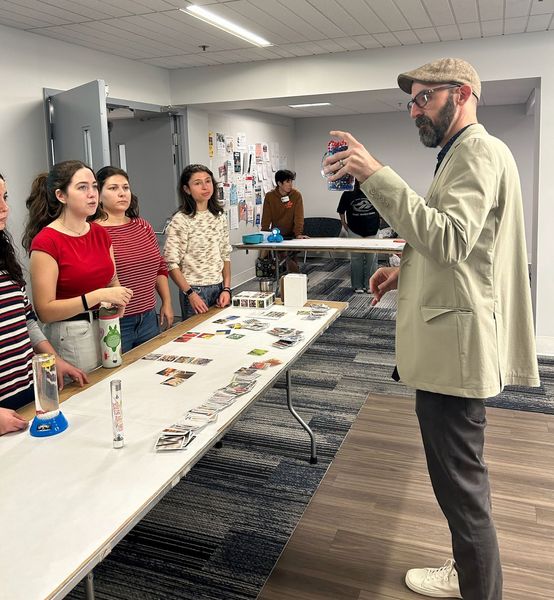Creating Opportunities Where STEM Learning Comes to Life

Students from Boston’s Trotter School learn about robotics from Instructional Lab Manager Moriah Lim. Photo by TJ McKenna.
Creating Opportunities Where STEM Learning Comes to Life
A BU–Boston Public Schools partnership brings students from the Trotter School to campus to explore STEM
On a crisp October morning during the first day of Massachusetts STEM Week, the William Monroe Trotter K–6 School brought its spirit of curiosity and discovery to Boston University. The day started as early 70 students from the Trotter School filled the BU Wheelock lobby, joined by BU undergraduates from ED 350: Sensemaking in STEM and Elementary Science Methods. Hands-on investigations designed and led by BU students transformed the space into a vibrant hub of learning.

Laughter and surprise filled the air as students discovered connections between circuits, creativity, and curiosity across each station. Working together, BU and Trotter students explored phenomena that made abstract science concepts tangible. Using Makey Makey kits, they turned everyday objects into interactive instruments. Bananas, peppers, sunflowers (even the petals worked when connected to the stalk), and artichokes became keys that triggered sounds and actions on the computer. At other stations, they created water tornadoes, programmed DASH robots and Ozobots that combined art and STEM, experimented with kinetic sand and flying helicopters, and investigated science through M&Ms.
This event, hosted by Boston University Government and Community Affairs and BU Wheelock, was part of a long-standing partnership with the Trotter School. The collaboration brought together faculty, university students, and school educators to create an immersive, community-centered day of learning, and was coordinated by Brianne Brown, a reading specialist at the Trotter School and the BU/Trotter liaison, and co-organized by me.
Throughout the visit, BU students acted as both mentors and learners, guiding younger students while deepening their understanding of how to make science meaningful and inclusive. The experience served as more than just a set of activities; it was a living demonstration of what authentic, sensemaking-based science learning can look like. BU’s students learned alongside the Trotter students, refining their skills as facilitators of inquiry and observing firsthand how curiosity unfolds in real time.


Exploring BU’s STEM innovation ecosystem
After the morning’s investigations, the Trotter students set off on a campus-wide adventure, accompanied by their BU student guides. The day’s rotations took the groups to three of BU’s most dynamic innovation spaces: the Duan Family Center for Computing & Data Sciences (CDS), the Engineering Product Innovation Center (EPIC), and the Robotics and Autonomous Systems Teaching and Innovation Center (RASTIC).


At EPIC, students witnessed the complete journey from idea to invention, seeing how engineers use cutting-edge tools to prototype and test their designs. The scale and sophistication of the facility helped students connect their classroom experiments to the world of professional engineering.
Down the street at RASTIC, groups encountered robotics in action. Mechanical engineering PhD student Chae Woo Lim, who researches soft robotics, shared insights into graduate-level research. During the conversation, a Trotter sixth grader posed a profound question: “Can you program robots to have feelings?”
Rather than offering a simple answer, Chae Woo turned the inquiry back to the students, asking them to consider what a feeling actually is and what it means for us as humans to experience emotions. The conversation naturally evolved toward the challenge at the heart of affective computing and social robotics: to program something as complex as emotion, we must first be able to define it, measure it, and translate human experience into data and algorithms that machines can process. This exchange exemplified the kind of thoughtful mentorship that makes these partnerships so valuable—honoring student curiosity while deepening their understanding of both science and themselves.
The Center for Computing & Data Sciences, affectionately known to many as “the Jenga Building,” served as a particularly fitting launch point for STEM Week. As BU’s largest green building and most sustainable structure, CDS embodies the intersection of innovation and environmental responsibility that defines modern STEM education. Students took in sweeping views of campus and the Boston skyline from the 17th floor while engaging in conversations about the variety of academic paths available at BU. Staff members pointed out the different colleges visible from that vantage point, describing what students study at each and encouraging the Trotter students to envision the breadth of possibilities in higher education
STEM, sensemaking, and future pathways
The day concluded with lunch at Warren Towers, where conversations turned to college life and future aspirations. Bringing a group of 50-plus fifth and sixth graders into a bustling dining hall on a rainy Monday certainly added a layer of joyful energy to the space.
One thing that made the moment particularly memorable was the spontaneous response from BU undergraduates who were simply there for lunch. BU students warmly engaged with the Trotter visitors, striking up conversations about dorm life, their academic experiences, and how they navigated the college application process. Their kindness and openness transformed what could have been logistical complexity into genuine connection, making higher education feel both welcoming and attainable. This organic mentorship speaks volumes about the character and generosity of BU’s student body.
The impact of the day was evident even before the buses pulled away. On the walk back and while lining up to board, students buzzed with excitement, sharing stories about the robots, machines, and experiments that had sparked their imaginations. Teachers reported that the visit had opened new pathways for inquiry, inspiring students to see STEM not as a subject but as something they do.
This partnership stands as a model for what Massachusetts STEM Week is all about: creating opportunities where learning feels alive, collaboration bridges communities, and every student, from fifth graders to future education professionals, sees themselves as a scientist in the making.
TJ McKenna is a clinical assistant professor in science education at BU Wheelock College of Education & Human Development. He is also the director of the Center for STEM Professional Learning at Scale and associate director of educator engagement and impact at the AI & Education Initiative.

Comments & Discussion
Boston University moderates comments to facilitate an informed, substantive, civil conversation. Abusive, profane, self-promotional, misleading, incoherent or off-topic comments will be rejected. Moderators are staffed during regular business hours (EST) and can only accept comments written in English. Statistics or facts must include a citation or a link to the citation.